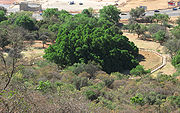
Wonderboom Nature Reserve
Encyclopedia
The Wonderboom Nature Reserve is a 1 km² reserve centered on a wild willowleaf fig tree Ficus salicifolia
that is more than a thousand years old, found towards the north of the Magaliesberg
Mountains in the Northern portion of the Pretoria
Metropole, South Africa
.
 The famous tree is situated at the foot of the Magaliesberg and is currently protected from human traffic around its trunk and roots. As it has grown, its outlying branches have rooted themselves round the parent tree. This has repeated until there are now three circles of daughter trees encircling the mother fig, with 13 distinct trunks, covering a 50m area.
The famous tree is situated at the foot of the Magaliesberg and is currently protected from human traffic around its trunk and roots. As it has grown, its outlying branches have rooted themselves round the parent tree. This has repeated until there are now three circles of daughter trees encircling the mother fig, with 13 distinct trunks, covering a 50m area.
"Wonderboom" is the Afrikaans
name that translates as "Wonder Tree," or more accurately "Miracle Tree."
Other features of the Wonderboom Nature preserve include a stone age site that has given up the largest single accumulation of Neolithic
tools ever found in South Africa and an Iron Age
site, as well as a breeding pair of Black Eagles
. One of the historic Boer forts
constructed towards the end of the nineteenth century in Pretoria, is located on top of the Magaliesberg within the boundaries of the reserve. The ruins of the fort can be reached by paved walkway and offer superb views of the city. Larger antelope species, such as impala, and zebra are also found on the reserve.
Ficus
Ficus is a genus of about 850 species of woody trees, shrubs, vines, epiphytes, and hemiepiphyte in the family Moraceae. Collectively known as fig trees or figs, they are native throughout the tropics with a few species extending into the semi-warm temperate zone. The Common Fig Ficus is a genus of...
that is more than a thousand years old, found towards the north of the Magaliesberg
Magaliesberg
The Magaliesberg is a mountain range extending from Pretoria in the north of the Gauteng Province to a point south of Pilanesberg, in the North West Province, South Africa...
Mountains in the Northern portion of the Pretoria
Pretoria
Pretoria is a city located in the northern part of Gauteng Province, South Africa. It is one of the country's three capital cities, serving as the executive and de facto national capital; the others are Cape Town, the legislative capital, and Bloemfontein, the judicial capital.Pretoria is...
Metropole, South Africa
South Africa
The Republic of South Africa is a country in southern Africa. Located at the southern tip of Africa, it is divided into nine provinces, with of coastline on the Atlantic and Indian oceans...
.

"Wonderboom" is the Afrikaans
Afrikaans
Afrikaans is a West Germanic language, spoken natively in South Africa and Namibia. It is a daughter language of Dutch, originating in its 17th century dialects, collectively referred to as Cape Dutch .Afrikaans is a daughter language of Dutch; see , , , , , .Afrikaans was historically called Cape...
name that translates as "Wonder Tree," or more accurately "Miracle Tree."
Other features of the Wonderboom Nature preserve include a stone age site that has given up the largest single accumulation of Neolithic
Neolithic
The Neolithic Age, Era, or Period, or New Stone Age, was a period in the development of human technology, beginning about 9500 BC in some parts of the Middle East, and later in other parts of the world. It is traditionally considered as the last part of the Stone Age...
tools ever found in South Africa and an Iron Age
Iron Age
The Iron Age is the archaeological period generally occurring after the Bronze Age, marked by the prevalent use of iron. The early period of the age is characterized by the widespread use of iron or steel. The adoption of such material coincided with other changes in society, including differing...
site, as well as a breeding pair of Black Eagles
Verreaux's Eagle
Verreaux's Eagle , alternatively known as the Black Eagle , is a large bird of prey. This eagle lives in hilly and mountaineous regions of southern and eastern Africa , and very locally in Western Asia.- Description :It is long. Males weigh and females weigh...
. One of the historic Boer forts
Pretoria Forts
The Pretoria Forts consisted mainly of four forts built by the government of the South African Republic just before the outbreak of the Second Anglo-Boer War around Pretoria....
constructed towards the end of the nineteenth century in Pretoria, is located on top of the Magaliesberg within the boundaries of the reserve. The ruins of the fort can be reached by paved walkway and offer superb views of the city. Larger antelope species, such as impala, and zebra are also found on the reserve.
External links
- Wonderboom Nature Reserve
- The Wonderboom
- Wonderboom Giant Fig Tree (360 virtual tour)
- Ruins of Fort Wonderboom (360 virtual tour)

